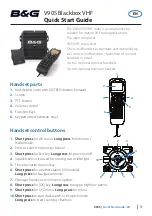
36
9
SCAN OPERATION
■
Scan types
Scanning searches for signals automatically and makes it
easier to locate new stations for contact or listening purposes.
There are 3 scan types and 5 resume conditions to suit your
operating needs.
FULL SCAN
(p. 37)
Repeatedly scans all frequen-
cies over the entire band.
Used as the simplest scan
without any preliminary set-
tings necessary.
Band
edge
Band
edge
Scan
Jump
PROGRAMMED SCAN
(p. 37)
Repeatedly scans between
two user-programmed fre-
quencies. Used for checking
for frequencies within a speci-
fied range such as repeater
output frequencies, etc. 3
pairs of scan edges are avail-
able.
Band
edge
Band
edge
Scan
Jump
Scan edges
MEMORY SCAN
(p. 37)
Repeatedly scans memory
channels except those set as
skip channels. Used for often-
called channels and for by-
passing normally busy
channels such as repeater
frequencies.
SKIP
SKIP
M 1
M 5
M 2
M 3
M 4
M 6
M 100
M 7
SCAN RESUME
CONDITION
(p. 41)
5 resume conditions are avail-
able: 3 timer scans, pause
scan and empty scan. When
receiving a signal, pause
scan pauses until the signal
disappears; timer scans
pause for 5, 10 or 15 sec.
Empty pause scan pauses
until a signal appears.
Pause
scan
Receiving
a signal
Timer
scan
Empty
pause
scan
Pausing
Pausing
2 sec.
2 sec.
☞
NOTE: A tone scan function is available to search for sub-
audible tones (e.g. when you want to find a subaudible
tone frequency necessary to open a repeater). See p. 48
for details.
















































